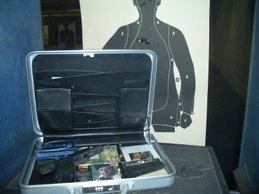One of my favorite things about opera is that it’s never constrained by reality. To wit, the great tuberculosis aria or solo scenes, which involve the heroine, a soprano, belting out a huge aria in her bed as she wheezes to death of “consumption,” as tuberculosis was colloquially called in the 19th century. These “Tuberculosis Arias,” as I colloquially call them, are usually the climatic scene of the opera; once the soprano falls, the curtain is soon to follow.
Tuberculosis was all the rage in the 19th century. Several artistic celebrities succumbed to its seduction, including Frédéric Chopin, Honoré de Balzac, Aubrey Beardsley, John Keats, the Brontë family, Robert Louis Stevenson, Franz Kafka, gunslinger John "Doc" Holliday, Albert Camus, Sir Arthur Conan Doyle’s and Fyodor Dostoyevsky’s first wives, and even George Orwell (I had to throw him in because I love his letters).
Add to this list Violetta Valéry, heroine of Verdi's "La Traviata" (1853), and Mimì, the heroine of Puccini's "La Bohème" (1896).
A side note for the curious. "La Traviata" literally means “The Woman Who Strayed,” and is taken from the novel La dame aux Camélias, by Alexandre Dumas, which later inspired all 10 versions of the movie Camille (my favorite is the 1936 version with Greta Garbo). It’s great feminist literature. Incidentally, the Broadway musical and subsequent movie Rent is based on La Boheme and the death-by-tuberculosis theme inspired the modern film adaptation of Moulin Rouge. Guess opera isn’t so out-of-date after all.
Extreme OperaRecently I subjected my wife to a performance of Traviata at the Metropolitan Opera in New York City during an ice storm. She has yet fully to forgive me. On this March day, NYC was deluged with six inches of not rain nor snow but SLUSH. Yes, as if NYC needed any more of that.

Nor was this the first time my long-suffering wife risked her life to indulge my leisurely pursuits. There was the time we went skiing in Austria during a blizzard whiteout, when there was so much snow that you couldn’t see five feet in front of you, yet you’re traveling 30 mph (50 kph in Europe). This despite the avalanche-warning sirens wailing in the background and Herman Meyer himself taking the chairlift to the lodge. It’s all rather surreal until you plunge into a 1000-foot (or 304-meters) Alpine ravine, as we almost nearly did. If that ever happens to you, you should know that the Austrians will only laugh at you and dig out your corpse in the spring.
After the performance, we skidded out into Broadway in our patent leather shoes to hail a cab with the thousands of other hard-core opera-goers, average age: 66. However, it quickly turned into a mortal version of the ancient arcade-game “Frogger,” as we all frantically dodged the South Asian taxi drivers talking on their cell-phone while maneuvering their 2000-pound cabs on bald-tires.
A small contingent of us made it to Central Park, where, in the face of stinging wind not felt since US Army Ranger School (Desert Phase), we hailed down a taxi driven by a West African. Now, you don’t need to live in West Africa, as I have, to know that snow and West Africans are an unholy combination.
Desperate, we jumped in and endured a kamikaze sleigh ride down the West Side Highway at 60 mph, all the way down to the bottom of the Financial District, where we were staying. It made me religious. I’ve been an atheist in foxholes before, but there was something profoundly undignified about dying at the hands of a Nigerian hydroplaning on Manhattan ice-slush. There was simply too much unflattering symmetry in the whole event to render it an acceptable means of soul trans-migration.
Dying DivasTraviata charts the tragic fall of a young Parisian courtesan, Violetta Valéry, literally the toast of the town. Fickle, she swears off love, declaring she must be free to enjoy life (her famous “Sempre libera” – Always Free aria). Then steps in Alfredo Germont and, despite herself, Violetta falls in love.
Listen to the indefatigable Angela Gheorghiu live it:
An act later, they are married and have exchanged their champagne nights for Diet Coke days in the suburbs, where the chagrined Violetta is secretly selling her jewelry in order to buy the groceries. Things are at their bottom when Alfredo's father pops by and demands that she leave Alfredo, as her party-girl reputation is ruining his future, his sister’s ability to marry up, and the Germont family name. Withering under the weight of her life, Violetta feebly agrees, invoking her old mantra, “Sempre libera,” as she departs.

In grief, Violetta becomes sick and impoverished. Alfredo, who does not know about his father’s furtive visit, assumes that she ran off with another man. This so enrages him that he later throws money at her, as if she was a whore, at a grand ball, disgracing her before all of society. Now the Hester Prynne of Paris, she retreats to a small, squalid apartment, where she contracts tuberculosis.
It is only at the very end of the opera, when Alfredo realizes that she sacrificed herself for him, that he comes to her side. But he is too late. She is in the clutches of the disease. Enfeebled, Violetta coughs between her dark notes as Alfredo, his father, and the doctor helplessly watch her whither away. As the moment of death approaches, the soprano does the most arresting thing – she speaks. Punctuating the gravity of the situation with the only non-sung words in the opera, Violetta declares that the pain is gone and she is free once more. Then, with lungs of iron, Violetta bolts up in bed and belts out, in tones that would make Liza Minnelli cower, that she is coming back to life, to the tune of “Sempre libera.” She dies, and the curtain falls.
Listen to Maria Callas die of tuberculosis:
Boheme is hardly less tragic. It stars four Bohemians and a young woman, Mimì. A “Bohemian,” in 19th century parlance, referred to the original Beatnik generation of artistic malcontents who inhabited the low-rent Latin Quarter of Paris. The real Bohemia was the land of today’s western Czech Republic, which (I assume) was rather artistic and libertine at the time. Johnny-Come-Latelies, like Picasso and Hemingway, tried to pretend they were Bohemian cool, but in truth the movement had come and gone before they stamped it on their street-cred resume.

Boheme opens with the raucous boy-Bohemian club that have made a decrepit Parisian attic into their ultra-cool artistic tree house. As they burn their art to keep warm and then head off to the local café, Mimì enters, the poor girl from downstairs, looking for someone to light her candle. Rodolfo, the poet of the entourage, is attracted to her, and remains as his companions leave for some midnight wine. Rodolfo sings to her about the noble life of the poet, in his magnificent aria “Che gelida manina - What a cold little hand.” Within the space of a single song, Puccini renders a tale of hope, achieved through beauty, of the heroic artist.
Mimì replies with a more humble but more poignant aria of her modest life as a seamstress, “Mi chiamano Mimì – They call me Mimì.” Despite her oppressive poverty, she finds escape in the gentle embroideries of nature, which raise her above the tyrannical life of the sweatshop. The music intensifies around her and apogees in a heavenly anthem, liberating her from the dingy confines of the slum.
As Rodolfo’s frat-boy chums call to him from the street to get his lazy-ass down and join them at the café, Rodolfo starts winding up for one of opera’s most beautiful duets, “O soave fanciulla - Oh gentle maiden,” in which Rodolfo and Mimì fall in love. He softly begins by declaring that love alone commands him, and as he crescendos to his high notes, Mimì swoops in with her own high notes, joining in sublime harmony. Arm in arm, their song sweetly fades away as they head off to the bedroom backstage. Amore!
Listen to Pavoratti and Freni get it on:
Things never go as planned. Weeks and complications later (including the knock-out duet “Quando me'n vo - When I go along,” but we’ll save that for another time), they are estranged. Mimì has contracted tuberculosis in her damp and drafty apartment, and Rodolfo, penniless but madly in love, painfully dumps her so that she might find a richer boyfriend who can help her. Mimì, crushed, retreats to her damp and drafty apartment.
The final act takes place later, and Mimì, by this time, is alone and very ill. One of the Bohemians’ girlfriends, Musetta (a great character but again for a later blog), announces that Mimì is dying, and they all go downstairs to fetch her. Pale and ghostly, they place her in their bed, and scrounge all their possessions to sell to find medicine. Colline, their philosopher, even sells his faithful old overcoat, and sings his agonizing "Vecchia zimarra – Old coat" aria.
Mimì and Rodolfo, left alone, recall their past happiness in the duet “Sono andati? – Have they gone?” and Puccini adds poignant overtones from their earlier love duet. The others soon return with medicine but too late. Quietly, they watch her slip away. Rodolfo cries out Mimì's name and starts sobbing over her lifeless body as the curtain drops. Fin.
Listen to De Los Angeles croak:
Drum Roll Please…Demobilizing Charles Taylor’s army in Africa was easier than recommending a recording of these two operatic war horses. In fact, even choosing a lead soprano – Tebaldi verses Callas – is enough to start a brawl in the Dress Circle. There is absolutely nothing scarier than a gay man in tails smashing off the head of his champagne flute on a marble cocktail table and lunging towards your juggler with the crystal stem like a juggernaut trained by the Ballets Russes. (To learn more about gay-man soprano fetish, read the excellent book The Queen's Throat by Wayne Koestenbaum).
What does a hardened, veteran mercenary fear most in the world? RPG-wielding child soldiers in Sierra Leone? NO! Sunni militia men bearing power-drills? NO! Serbs with 7.62mm SVDS Dragunov sniper rifles? NO! Somalis in Toyota Hilluxes with pedestal mounted DShKs (‘dishkas’)? NO! Chinese food delivery vehicles in San Francisco? NO! What a mercenary fears most is castration by the Velvet Mafia.
At such risk, I now give my (gulp) recommendations to these most revered of operas. For a modern version of Verdi’s La Traviata, you cannot go wrong with conducting legend
Sir Georg Solti’s 1994 version, one of his last recordings before he died three years later. This recording, in outstanding sound and also available as a DVD, debuts the amazing Romanian super-star Angela Gheorghiu as Violetta (ASIN: B00000427V). She’ll have you convinced she’s singing on blow.

However, there are those who would sacrifice their first-born (or first-adopted) to be present at the
1958 performance of Maria Callas at Lisbon, Portugal, conducted by Franco Ghione. For those who don’t have first-born, this performance was captured live by EMI engineers, although in sub-optimal sound. If you want to know why so many people go ga-ga over Callas, give this a spin (ASIN: B000002RY7).

If there is an opera more challenging than Traviata to pick a favorite, it’s Puccini’s La Boheme, which may be one of the most performed operas ever. Incidentally, it bombed on opening night. It was eclipsed by his friend, composer Leoncavallo (the original one-it wonder with Pagliacci) who premiered his version of La Boheme months later and all the critics went crazy over it (see last blog entry on critics). Needless to say, Puccini and Leoncavallo were no longer friends after that. Opera takes no prisoners.
Many consider the
first commercial recording of Boheme to be the finest. It was conducted by Sir Thomas Beecham with Spanish soprano Victoria de Los Angeles, who inspired him to record it, and Swedish tenor Jussi Bjoerling. This mono 1956 recording is available widely and cheaply (ASIN: B000063UM0).

However, my all around favorite is Herbert von
Karajan’s 1973 stereo version with his favorite soprano, Mirella Freni, and a young Luciano Pavarotti at his peak (unlike his post-climatic self these last decades). This is a great starter version, from which you can graduate to the Tebaldi-Callas duel (ASIN: B0000041TR). Have the champagne flute-stems at the ready…


















































